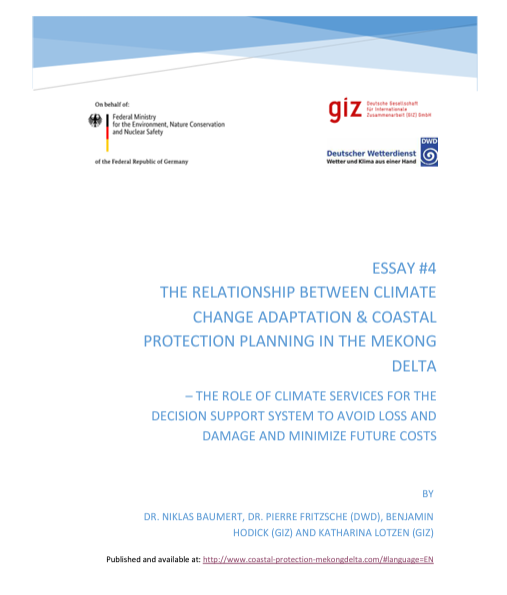The Relationship between Climate Change Adaptation & Coastal Protection Planning in the Mekong Delta: the Role of Climate Services

Summary
This resource was submitted by the Climate Risk Institute fortheCanAdapt Climate Change Adaptation Community of Practice.
This article is an abridged version of the original text, which can be downloaded from the right-hand column. Please access the original text for more detail, research purposes, full references, or to quote text
The Decision Support Tool (DST) for the Coastal Protection for the Mekong Delta (CPMD) provides an analysis of the current geographical, geological and hydrological situation along the Mekong Delta’s coastline. Besides a surveillance of changes of the coastal regimes over the last decades until today, it also includes an assessment of the major coastal protection infrastructure, including dykes and sluice gates, embankments as well as eco-based foreshore protections such as the mangrove belt.
The combination of coastal regime analysis (including changes in the past) with a description of protective qualities of the coastal infrastructure provides thorough information about the existing exposure and basic vulnerability of the delta’s coastline. It is therefore possible to indicate a risk-level that offers the basis for a prioritization of newly planned protection infrastructure.
Climate Change, however, adds the future as a new perspective and changes the parameters of the DST “equation” through the application of different climate models and scenarios. In conjunction with different local downscaling applications, the result will be a medium or long-term timeline with different degrees of certainty towards changes in local temperature, sea level rise and weather patterns, including hazards and potential extreme weather events.
Thus, the DST can also offer a way to include climate information and apply future scenarios in its decision-making advice for coastal infrastructure. For this, it needs to incorporate climate information and products tailor-made to be used in decision-making and planning processes, so called Climate Services (CS). If not applied, the vulnerability of coastal infrastructure will increase along with higher rates of loss and damage. Consequently, this essay will not only deal with the question how Climate Services (CS) provide necessary added value to the CPP, but what financial investment planning has to bear in mind to avoid an acceleration of future costs due to inaction in adaptation.
Related resources
- The Coastal Hazard Wheel - a universal coastal adaptation language
- Rising Seas and Shifting Sands: Combining Natural and Grey Infrastructure to Protect Canada’s Coastal Communities
- Slow-onset climate hazards in Southeast Asia: Enhancing the role of social protection to build resilience
- The Importance of Floodplain Restoration for Mangroves
- Helping Small Island Developing States adapt to climate change using coastal ecosystem-based approaches
(0) Comments
There is no content